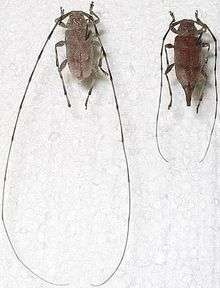Timberman beetle
The Timberman Beetle (Acanthocinus aedilis) is a species of beetle belonging to the Longhorn beetle family,[1] which is a Woodboring beetle.
| Timberman beetle | |
|---|---|
 | |
.jpg) | |
| Scientific classification | |
| Kingdom: | Animalia |
| Phylum: | Arthropoda |
| Class: | Insecta |
| Order: | Coleoptera |
| Family: | Cerambycidae |
| Subfamily: | Lamiinae |
| Genus: | Acanthocinus |
| Species: | A. aedilis |
| Binomial name | |
| Acanthocinus aedilis | |
| Synonyms | |
| |
It is found in woodlands in with a large distribution through Europe, Russia and Central Asia. It is also known as the Siberian Timberman due to its range extending northwards in to Siberia.[2] In Dutch this species is known as Dennenboktor and in Swedish as Större Timmerman.[3] For more vernacular names see the GBIF profile.[4] Despite a few sources suggesting reports in Central America, no confirmed reports were available at time of editing (May, 2020). The species is also not listed as invasive in North America.[5]
The body length ranges from 12-20mm, with antennae up for 3 times the body length in males, or 1.5 times the body length in females.[2] Their lifespan is up to 3 years which includes the 1–2 years spent in the larval stage.[6]
This species is capable of surviving freezing temperatures below -37 °C in both the adult and larval stages.[7] The adults are active from March to June, during which they are Diurnal.[2] The adults overwinter in pupal chambers in leaf litter or under the bark.[8]
In Continental Europe, this species has become a serious pest of commercially-grown timber as the larvae feed under the bark, weakening the trees.[2] Through infesting weakened trees, excavating galleries under the bark, the trees then die.[8] Their development within wood debris in natural forests is beneficial for nutrient cycling in forest ecosystems, but can also facilitate the transfer of pathogenic fungi within woodlands.[9] Scots pine (Pinus sylvestris L.) and Norway Spruce (Picea abies) are key food sources for this beetle species.[1]
A distribution map within the UK can be found courtesy of the National Biodiversity Network.[10][11] The species is reported to be Nationally Scarce category B within Great Britain by the Wildlife Trust BCN in 2018.
References
- https://eol.org/pages/118244
- https://www.ukbeetles.co.uk/acanthocinus-aedilis
- http://www.eu-nomen.eu/portal/taxon.php?GUID=urn:lsid:faunaeur.org:taxname:114036
- https://www.gbif.org/species/10595482
- https://www.invasive.org/browse/subinfo.cfm?sub=10205
- https://www.uksafari.com/longhorn_timberman.htm
- Kristiansen E, Li NG, Averensky AI, Laugsand AE, Zachariassen KE. The Siberian timberman Acanthocinus aedilis: a freeze-tolerant beetle with low supercooling points. J Comp Physiol B. 2009;179(5):563‐568. doi:10.1007/s00360-009-0340-x
- https://wiki.bugwood.org/Archive:Atlas/Acanthocinus_aedilis
- Meshkova, Valentyna & I., Kochetova & Ye, Skrylnik & Zinchenko, O.. (2017). Seasonal development of the timberman beetle Acanthocinus aedilis (Linnaeus, 1758) (Coleoptera: Cerambycidae) in the North-Eastern Steppe of Ukraine. Annals of the Entomological Society of America. 25.
- https://www.coleoptera.org.uk/species/acanthocinus-aedilis
- https://species.nbnatlas.org/species/NBNSYS0000011056
Insect Natural History, A.D.Imms, Collins, 1973

